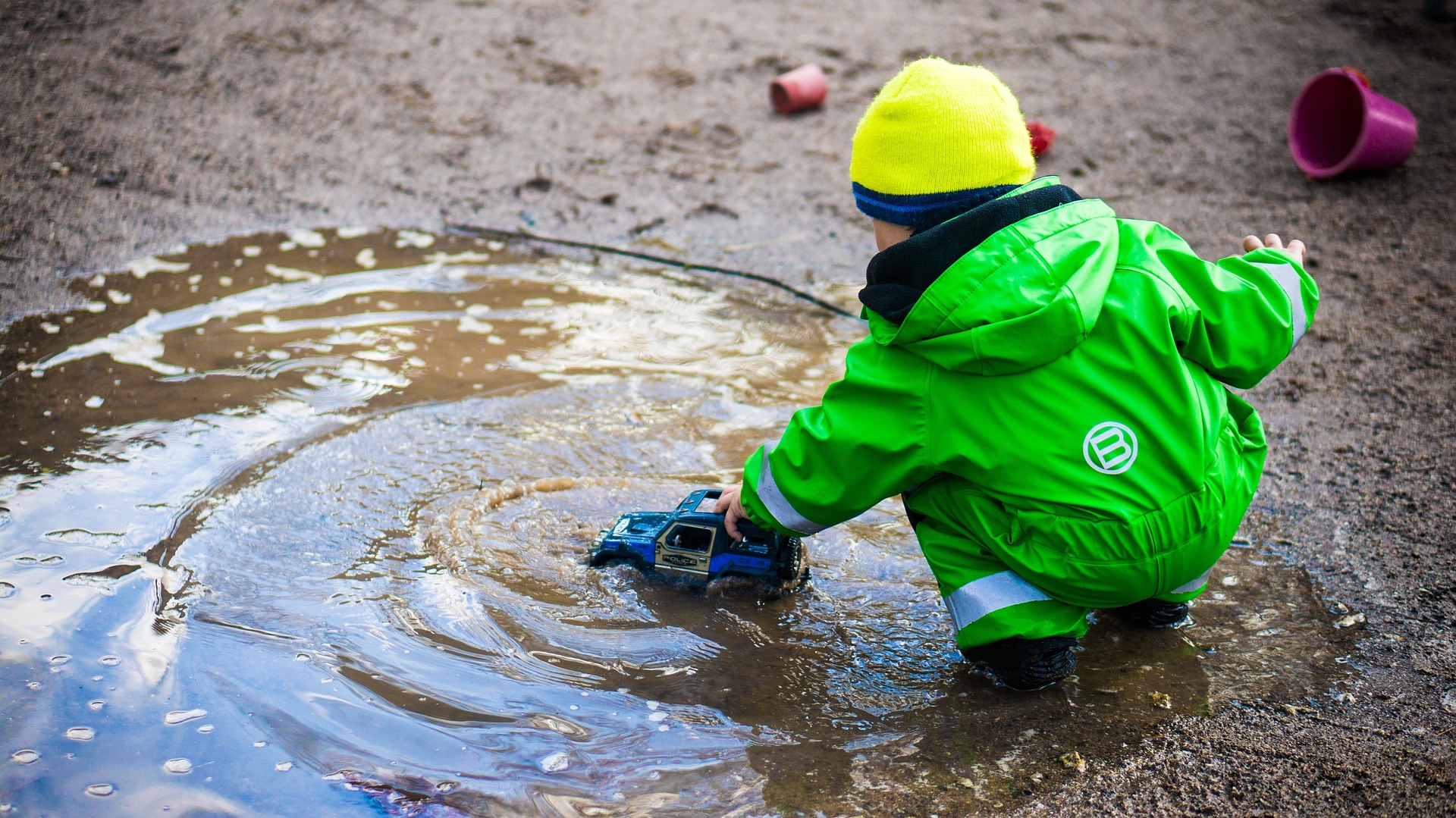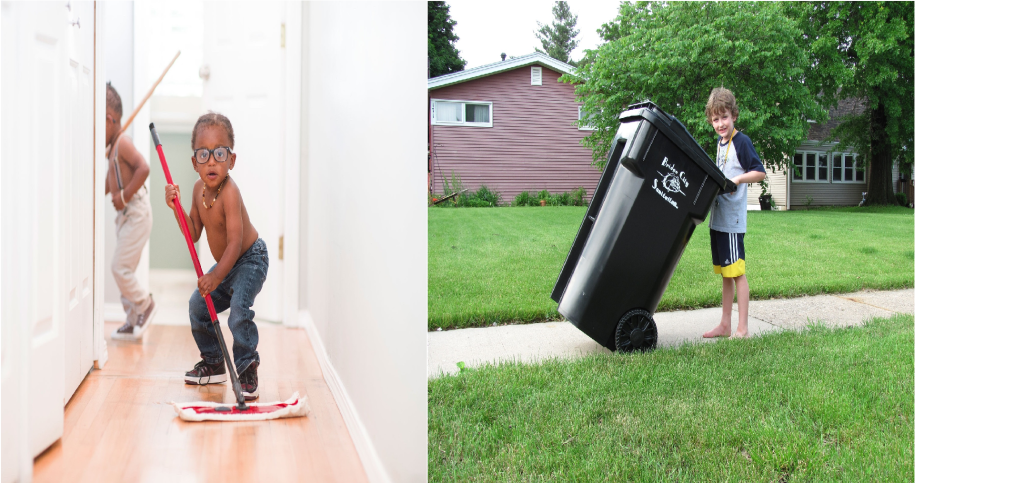4.5 Parenting Styles and Behaviors
Parents significantly influence a child’s psychosocial development during the socialization that occurs in families. Psychosocial development refers to the intersection of social, cultural, and environmental influences on the mind and behavior. Parenting is the process of nurturing, caring for, socializing, and preparing one’s children for their eventual adult roles.[1] Additional factors can also influence a child’s psychosocial development, such as how a child responds to parenting, genetics, and peer influence. For example, one child might interpret parental oversight as caring that promotes their safety, whereas another child might interpret oversight as intrusive.[2]
Parental Responsiveness and Demandingness
Every parent is unique, but parenting styles can be categorized by their levels of parental responsiveness and parental demandingness. Parental responsiveness refers to parental support and/or emotional warmth, while parental demandingness refers to behavioral control.[3] See Figure 4.6[4] for an image of a mother demonstrating parental responsiveness.

Table 4.5a summarizes parenting styles based on levels of parental responsiveness and parental demandingness, ranging from uninvolved or permissive to authoritarian or authoritative.
Table 4.5a. Parenting Styles Based on Parental Responsiveness and Demandingness[5],[6]
| Demand Level | Low Responsiveness | High Responsiveness |
|---|---|---|
| Low | Uninvolved parents: Uninvolved parents exert low control and discipline, as well as low warmth and responsiveness. For example, they show no interest at all in a child’s school performance. Uninvolved parents may be neglectful of the child’s physical and emotional needs. | Permissive parents: Permissive parents exert low control and discipline with high warmth and responsiveness. They are lenient, allow considerable self-regulation by children, avoid confrontation, and do not enforce specific behaviors. For example, any school performance may be acceptable, and they fail to correct behavior that leads to bad grades. Permissive parents can be further divided into two types, called democratic or nondirective. Democratic parents, although lenient, are conscientious, engaged, and committed to the child, whereas nondirective parents are not. |
| High | Authoritarian parents: Authoritarian parents exert high control and discipline with low warmth and responsiveness. They are obedience- and status-oriented and expect their orders to be obeyed without explanation. These parents provide structured environments with clearly stated rules and discipline that may be punitive. For example, they may respond to bad grades with punishment but let good grades go unnoticed. Authoritarian parents may or may not exhibit intrusive behaviors. | Authoritative parents: Authoritative parents are demanding but also emotionally responsive. They clearly communicate and enforce standards for their children’s behavior. Disciplinary methods are effective and support the child’s development and acceptance of responsibility. For example, they offer praise for good grades and use discipline and guidance to help improve a child’s low grades. They are assertive, but not intrusive or restrictive. Authoritarian parents want their children to grow up to be assertive, self-regulated, socially responsible, and cooperative. |
Parenting styles are also characterized by a third dimension called psychological control. Psychological control refers to parenting practices such as guilt induction, withdrawal of love, shaming, or other intrusive acts that affect the psychological and emotional development of the child. A key difference between authoritarian and authoritative parenting is the dimension of psychological control. Both authoritarian and authoritative parents have high expectations for their children to behave appropriately and obey rules. However, authoritarian parents expect their children to accept their judgments, values, and goals without questioning, whereas authoritative parents explain the rationale for their rules, values, and goals with their children.[7]
Research has found that parenting styles predict a child’s well-being in the domains of social competence, academic performance, psychosocial development, and high-risk behavior[8]:
- Children and adolescents raised by uninvolved parents perform poorly in all domains.
- Children and adolescents raised by permissive parents are more likely to have problematic behavior and lower academic performance, but they tend to have higher self-esteem, better social skills, and lower levels of depression than those with permissive or authoritarian parents.
- Children and adolescents who are raised by authoritarian parents tend to perform moderately well in school without problematic behavior, but they often have poorer social skills, lower self-esteem, and higher levels of depression.
- Children and adolescents raised by authoritative parents tend to fare better in all domains with better developmental outcomes, such as body image, academic success, and use of alcohol and other substances. For example, adolescents with authoritative parents have the lowest risk for underage drinking because they learn approaches to problem-solving and emotional expression that help protect against the psychological dysfunction that often precedes alcohol misuse.[9]
Positive Parenting Behaviors
Parents can choose positive parenting behaviors that effectively guide their child’s development and manage their behavior. Positive parenting behaviors include good communication, effective discipline, socialization, and encouragement of responsibility.[10]
Good Communication
Good communication encourages healthy child development with consistent attempts to actively listen to the child and demonstrate warm feelings with nonverbal communication (like smiling and making eye contact) and physical affection (such as hugs or touching the head or shoulders).[11] Active listening helps promote bonding between parents and children. Elements of active listening include using eye contact, turning off mobile devices and screens, scheduling a time to connect (such as at mealtime), paying attention to the child, and validating their feelings. Parents should also read and talk to infants and young children to immerse them in language and help them become good readers and communicators.[12] See Figure 4.7[13] for an image of a parent using active listening with their child.

Conversely, commanding action, lecturing, criticizing, ridiculing, and belittling do not help children feel heard. Additionally, when children are playing, parents should let them create and play without telling them how they should improve.[14] See Figure 4.8[15] for an image of a child playing independently.

Families set the foundation for lifelong patterns of communication. Children develop strong relationships when they have effective communication skills. Helpful communication patterns for parents to use with children include the following[16]:
- Using “I” language rather than “you” language that can shut down communication and lead to blaming. For example, a parent can say, “I feel frustrated when you do not make your bed every morning” instead of, “You never make your bed in the morning.”
- Focusing on the behavior, not the child’s personality characteristic, to help the child build self-esteem. For example, the parent can say, “Cleaning your room makes a nice space to hang out,” instead of, “You are so lazy you don’t clean your room.”
- Focusing on the solution rather than the person promotes willing participation rather than defensive reactions. For example, the parent can state, “If you clean your room, you can have friends over,” instead of, “If you don’t clean your room, you can’t have friends over.”
- Teaching positive emotional regulation with calmness, acceptance, and kind words like please and thank you. For example, the parent can state, “I like it when you use good manners and say ‘Please’ and ‘Thank you.’”
- Providing attention while the child is behaving well. For example, “I feel happy when I see you sharing your toys nicely with your brother.”
Effective Discipline
Children need guidance from their parents who set healthy, specific rules and enforce consequences when these rules are not followed.[17] In this manner, parents teach and socialize children how to behave appropriately in the family and eventually in society.
Discipline is a tool used to train children to follow rules. Positive discipline can be viewed as guidance, compared to punishment that is negative and teaches children to be afraid. Discipline should be age appropriate. For example, assigning a time-out (i.e., sitting quietly without interaction from a parent) is an effective discipline tool for preschoolers. Time-outs should last one minute for every year of the child’s age. For example, two-year-old children should have two-minute time-outs. When the time-out ends, the parent should offer a hug, positive words about the child’s character, and reinforcement of the desired behavior.[18] Conversely, spanking has not been shown to be effective discipline and teaches children that people can hit to get what they want.[19]
For older children, effective discipline may include the short-term removal of a privilege. For example, a parent may discipline a teenager who did not follow a rule by not allowing them to interact with their friends after school for one evening. After the privilege is reinstated, the parent should restate the rule, offer positive attention, and reinforce the desired behavior.[20]
When parents use consequences as a discipline tool, the following steps should be used[21]:
- Identify clear guidelines for desirable and undesirable behavior. A warning should be provided if a child demonstrates undesirable behavior.
- Be specific about consequences that will occur if undesired behavior continues using “if – then” statements. The consequence should fit the behavior. For example, a parent states to a toddler, “We do not throw our toys. If you keep throwing the toy, I will take it away for today.”
- Follow through immediately on implementing the consequence if the behavior occurs again. If a consequence is stated, it should be delivered as stated. If parents express a consequence but do not apply it, the child learns they have no reason to change their behavior.
- Provide positive reinforcement for desired behavior after the consequence is administered.
Parents can help children correct undesirable behavior using behaviorism. Behaviorism means attention is provided for desired behaviors and undesired behaviors are ignored. For example, parents communicate approval and positive attention when the child is demonstrating good behavior to encourage this behavior to continue. Because children want to please their parents and caregivers, they are motivated to continue this behavior to receive approval. However, undesired behavior is ignored as long as the child is safe. For example, if a toddler throws a tantrum, the parents ignore the tantrum to discourage the behavior. After the tantrum ends, the parent teaches the child to recognize and name the emotion they are feeling and suggests acceptable ways to express it.[22]
Parents must intentionally, positively interact with a child to promote good behavior. If they don’t, the child may act out to gain attention because they perceive that any attention is better than none.[23]
Socialization
Parents socialize their children by teaching them how to interact with others and how to view themselves. When a child makes a mistake, parents should specifically name the undesired behavior but not characterize the child. For example, instead of saying, “You’re a bad boy,” the parent should say, “It is not acceptable to draw on the wall with your crayons.” In a similar manner, specific details should be given about what they did right when providing positive attention. For example, instead of stating a vague “Good job,” a parent should state, “I really like how you shared your toys with your sister.”[24]
Parents also teach empathy (understanding and sharing feelings of another) by modeling it. For example, a parent may state, “I see Johnny is sitting by himself on the park bench. He probably feels lonely. Let’s go invite him to play on the swings.” Conversely, children can also learn a lack of empathy by observing nonempathetic behavior by their caregivers.[25]
Parents influence a child’s self-esteem. Parents can help children value themselves and develop a growth mindset by helping them see a balance between their strengths and weaknesses. A realistic attitude to teach a child about their worth is to help them see they are good at some things (like many people are) and not so good at other things, but they can always learn how to be better. This perspective preserves child self-esteem, directs socially appropriate behaviors, and encourages their growth.[26]
Teaching Responsibility
Parents teach children how to behave responsibly as they develop into adults. When parents assign appropriate household chores according to their developmental level, children learn that life includes work, as well as play, and family members contribute to family functions.
Assignment of household chores should advance in complexity as they age. Parents must assign children the right amount of responsibility for their age and developmental level, or they may become overwhelmed.[27] See Figure 4.9[28] for images of children learning responsibility by performing household chores.

Parents can follow these tips for teaching their children responsibility[29]:
- Provide specific instructions including what, when, and how a job should be completed.
- Supervise and support the child as they complete their household tasks.
- Give praise and small rewards for tasks completed according to instructions. For example, a sticker chart can help motivate young children to complete desired behaviors like making their bed every morning.
- If a chore is repeatedly not completed according to instructions despite additional guidance, a consequence may be given. However, rewards and positive reinforcement for tasks done well are usually more effective than consequences.
Parental Traits and Qualities
Parents bring unique traits and qualities to their families such as age, gender, personality, cultural beliefs, developmental history, knowledge about parenting and child development, and mental and physical health. Parents who are conscientious and warmly respond to their children can provide a stable, secure family environment. Caregivers who are agreeable, less anxious, and less negative tend to support the development of their children’s autonomy more than caregivers who are anxious and less agreeable.[30] See Figure 4.10[31] for an image depicting warm, outgoing parents contributing to their child’s development.

Parents’ developmental histories (i.e., their experiences as children) affect their parenting strategies. Caregivers often repeat parenting practices they experienced from their own parents. Patterns of negative parenting and ineffective discipline are often unconsciously handed down from one generation to the next. However, caregivers who were dissatisfied with their parents’ approach may change their parenting style with their own children.[32]
Parents not only influence their children, but also children influence their parents. Characteristics of a child, such as their gender, birth order, temperament, personality, and health status can affect their parents’ behaviors. For example, an infant with an easy-going temperament can make their parents feel effective when they are easily soothed and smile. Conversely, a fussy infant who is difficult to soothe may cause the parent to feel ineffective and may result in fewer positive parent-child interactions. Over time, parents of children who exhibit challenging behaviors may become more punitive and less patient.[33]
Parenting styles can also be impacted by the psychological needs of the parent. Parents may adopt parenting characteristics that may be described as martyr, pal, police officer/drill sergeant, expert, or coach. See Table 4.5b for examples of these parenting characteristics and possible effects of these behaviors on the children’s development.[34]
Table 4.5b. Parenting Characteristics
| Name | Description |
|---|---|
| Martyr |
|
| Pal |
|
| Police Officer/Drill Sergeant |
|
| Parenting Expert |
|
| Coach |
|
In summary, parents help children develop into healthy adults who function well in society by using good communication, effective discipline, positive socialization, and teaching responsibility.
Sociocultural Characteristics Affecting Parenting
The parent–child relationship does not occur in isolation. Sociocultural characteristics, including a family’s economic status, cultural and religious beliefs, and neighborhood can influence parenting. For example, parents experiencing financial hardship can become frustrated and sad, and these emotions can affect their parenting skills.[35]
Cultural beliefs also influence parenting behaviors. Although a universal goal of parenting is to teach skills that are necessary to effectively function in one’s community, the specific skills can vary widely from culture to culture. For example, cultural beliefs may vary in how much individual autonomy and independence are valued versus maintaining group harmony embedded in a strong network of social relationships. These differences are reflected in parenting goals and expectations of children.[36]
Other important contextual characteristics such as the neighborhood can also affect parenting. For example, several studies have shown that parents who perceive their neighborhood as dangerous show less warmth to their children and tend to use more restrictive parenting practices. This parenting style may be considered adaptive because it may teach children to take care of themselves in a dangerous environment.[37]
- Giuliani, D. (2016). Sociology of family. Utah Valley University. https://pressbooks.pub/rdg097v1/ ↵
- Giuliani, D. (2016). Sociology of family. Utah Valley University. https://pressbooks.pub/rdg097v1/ ↵
- Giovannini, J. (2024). Children, families, schools, and communities [revised edition]. ROTEL (Remixing Open Textbooks with an Equity Lens) Project. https://rotel.pressbooks.pub/children-families-schools-communities/ ↵
- “mother-1171569_1920.jpg” by Neil Dodhia from Pixabay is licensed under CC0 ↵
- Giovannini, J. (2024). Children, families, schools, and communities [revised edition]. ROTEL (Remixing Open Textbooks with an Equity Lens) Project. https://rotel.pressbooks.pub/children-families-schools-communities/ ↵
- National Institute on Alcohol Abuse and Alcoholism. (2024). Parenting to prevent childhood alcohol abuse. https://www.niaaa.nih.gov/publications/brochures-and-fact-sheets/parenting-prevent-childhood-alcohol-use ↵
- Giovannini, J. (2024). Children, families, schools, and communities [revised edition]. Pressbooks. https://rotel.pressbooks.pub/children-families-schools-communities/ ↵
- Giovannini, J. (2024). Children, families, schools, and communities [revised edition]. ROTEL (Remixing Open Textbooks with an Equity Lens) Project. https://rotel.pressbooks.pub/children-families-schools-communities/ ↵
- National Institute on Alcohol Abuse and Alcoholism. (2023). Parenting to prevent childhood alcohol abuse. https://www.niaaa.nih.gov/publications/brochures-and-fact-sheets/parenting-prevent-childhood-alcohol-use ↵
- American Academy of Pediatrics. (2015). Communicating beyond the family. https://www.healthychildren.org/English/family-life/family-dynamics/communication-discipline/Pages/Communicating-Beyond-the-Family.aspx ↵
- American Academy of Pediatrics. (2015). Communicating beyond the family. https://www.healthychildren.org/English/family-life/family-dynamics/communication-discipline/Pages/Communicating-Beyond-the-Family.aspx ↵
- American Academy of Pediatrics. (2015). Communicating beyond the family. https://www.healthychildren.org/English/family-life/family-dynamics/communication-discipline/Pages/Communicating-Beyond-the-Family.aspx ↵
- “girl-1641215_1920.jpg” by Daniela Dimitrova from Pixabay is licensed under CC0 ↵
- American Academy of Pediatrics. (2015). Communicating beyond the family. https://www.healthychildren.org/English/family-life/family-dynamics/communication-discipline/Pages/Communicating-Beyond-the-Family.aspx ↵
- “kid-1350663_1920.jpg” by Arek Socha from Pixabay is licensed under CC0 ↵
- American Academy of Pediatrics. (2015). Communicating beyond the family. https://www.healthychildren.org/English/family-life/family-dynamics/communication-discipline/Pages/Communicating-Beyond-the-Family.aspx ↵
- Giuliani, D. (n.d.). Sociology of family. Utah Valley University. https://pressbooks.pub/rdg097v1/ ↵
- Centers for Disease Control and Prevention. (n.d.). Essentials for parenting toddlers and preschoolers. https://www.cdc.gov/ ↵
- Giuliani, D. (n.d.). Sociology of family. Utah Valley University. https://pressbooks.pub/rdg097v1/ ↵
- Centers for Disease Control and Prevention. (n.d.). Essentials for parenting toddlers and preschoolers. https://www.cdc.gov/ ↵
- Centers for Disease Control and Prevention. (n.d.). Essentials for parenting toddlers and preschoolers. https://www.cdc.gov/ ↵
- Giuliani, D. (n.d.). Sociology of family. Utah Valley University. https://pressbooks.pub/rdg097v1/ ↵
- Giuliani, D. (n.d.). Sociology of family. Utah Valley University. https://pressbooks.pub/rdg097v1/ ↵
- Giuliani, D. (n.d.). Sociology of family. Utah Valley University. https://pressbooks.pub/rdg097v1/ ↵
- American Academy of Pediatrics. (2023). Communication skills start at home. https://www.healthychildren.org/English/family-life/family-dynamics/communication-discipline/Pages/Components-of-Good-Communication.aspx ↵
- Giuliani, D. (n.d.). Sociology of family. Utah Valley University. https://pressbooks.pub/rdg097v1/ ↵
- American Academy of Pediatrics. (2024). Age-appropriate chores for children. https://www.healthychildren.org/English/family-life/family-dynamics/communication-discipline/Pages/Chores-and-Responsibility.aspx ↵
- Image is derivative of “kid-2586010_1920 (1).jpg” by StockSnap and “waste-384790_1920” Jarrod Blamey both from Pixabay and licensed under CC0 ↵
- American Academy of Pediatrics. (2024). Age-appropriate chores for children. https://www.healthychildren.org/English/family-life/family-dynamics/communication-discipline/Pages/Chores-and-Responsibility.aspx ↵
- Giovannini, J. (2024). Children, families, schools, and communities [revised edition]. ROTEL (Remixing Open Textbooks with an Equity Lens) Project. https://rotel.pressbooks.pub/children-families-schools-communities/ ↵
- “family-2899274_1920.jpg” by rbalouria from Pixabay is licensed under CC0 ↵
- Giovannini, J. (2024). Children, families, schools, and communities [revised edition]. ROTEL (Remixing Open Textbooks with an Equity Lens) Project. https://rotel.pressbooks.pub/children-families-schools-communities/ ↵
- Giovannini, J. (2024). Children, families, schools, and communities [revised edition]. ROTEL (Remixing Open Textbooks with an Equity Lens) Project. https://rotel.pressbooks.pub/children-families-schools-communities/ ↵
- Giovannini, J. (2024). Children, families, schools, and communities [revised edition]. ROTEL (Remixing Open Textbooks with an Equity Lens) Project. https://rotel.pressbooks.pub/children-families-schools-communities/ ↵
- Giovannini, J. (2024). Children, families, schools, and communities [revised edition]. ROTEL (Remixing Open Textbooks with an Equity Lens) Project. https://rotel.pressbooks.pub/children-families-schools-communities/ ↵
- Giovannini, J. (2024). Children, families, schools, and communities [revised edition]. ROTEL (Remixing Open Textbooks with an Equity Lens) Project. https://rotel.pressbooks.pub/children-families-schools-communities/ ↵
- Giovannini, J. (2024). Children, families, schools, and communities [revised edition]. ROTEL (Remixing Open Textbooks with an Equity Lens) Project. https://rotel.pressbooks.pub/children-families-schools-communities/ ↵
Refers to the intersection of social, cultural, and environmental influences on the mind and behavior.
The process of nurturing, caring for, socializing, and preparing one’s children for their eventual adult roles.
Refers to parental support and/or emotional warmth, while parental demandingness refers to behavioral control.
Behavioral control.
Parents who exert low control and discipline, as well as low warmth and responsiveness.
Parents who exert low control and discipline with high warmth and responsiveness.
Exert high control and discipline with low warmth and responsiveness.
Parents who are demanding but also emotionally responsive.
Refers to parenting practices such as guilt induction, withdrawal of love, shaming, or other intrusive acts that affect the psychological and emotional development of the child.
A tool used to train children to follow rules.
Sitting quietly without interaction from a parent.
Attention is provided for desired behaviors and undesired behaviors are ignored.
Parental account of their experiences as children.

